Overview of the Ground Water Flow System in Connecticut
Local climate, physiography and geology are largely responsible for the ground water conditions in the State. Although only 5,009 square miles in area, Connecticut has a significant range in precipitation both in time (seasonal and long-term hydrology) and space (northwest to southeast).
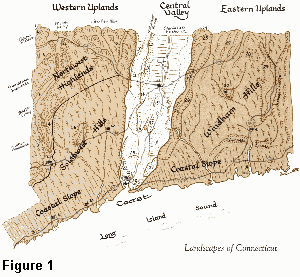 Median annual precipitation ranges from 42 to 52 inches with about half returning to the atmosphere by evapotranspiration. From 7 to 20 inches of precipitation on the average percolates to the saturated zone, and the remainder flows overland to surface-water bodies.
Median annual precipitation ranges from 42 to 52 inches with about half returning to the atmosphere by evapotranspiration. From 7 to 20 inches of precipitation on the average percolates to the saturated zone, and the remainder flows overland to surface-water bodies.
Eastern and Western Connecticut have moderate relief and are underlain by crystalline rocks. The Connecticut Valley has low to moderate relief and is underlain by a sequence of interbedded sedimentary and igneous rocks. Unconsolidated glacial sediments discontinuously mantle the bedrock, containing stratified drift predominately as elongate valley deposits. Two principal types of aquifers are formed by these geologic conditions. 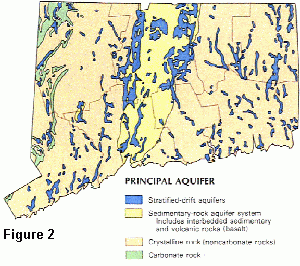 The unconsolidated stratified drift aquifers composed of sand and gravel are the most productive sources of water and can yield between 1 and 10 millions gallons of water per day. These aquifers are widespread in the Connecticut Valley while in other valleys are less extensive or non-existent. Bedrock aquifers underlie the entire State and are the source of most self-supplied water, commonly in the range of 3 to 5 gallons per minute. These aquifers are broadly subdivided into sedimentary, crystalline, and carbonate rock types. [See Figures 1 & 2]
The unconsolidated stratified drift aquifers composed of sand and gravel are the most productive sources of water and can yield between 1 and 10 millions gallons of water per day. These aquifers are widespread in the Connecticut Valley while in other valleys are less extensive or non-existent. Bedrock aquifers underlie the entire State and are the source of most self-supplied water, commonly in the range of 3 to 5 gallons per minute. These aquifers are broadly subdivided into sedimentary, crystalline, and carbonate rock types. [See Figures 1 & 2]
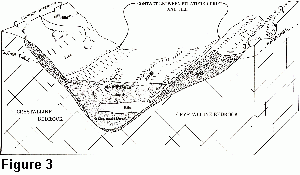 Ground water recharge is mainly from precipitation over the drainage basin. Water percolates from the land surface through the till, stratified drift, or along bedrock fractures to the water table. [See Figure 3]
Ground water recharge is mainly from precipitation over the drainage basin. Water percolates from the land surface through the till, stratified drift, or along bedrock fractures to the water table. [See Figure 3]
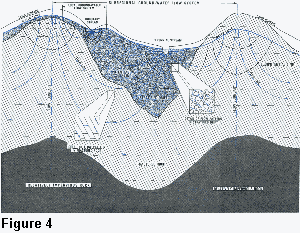 The flow of ground water in Connecticut is concentrated in the upper part of the saturated zone, (below the water table), generally within 300 feet of the surface. Because of the relatively shallow depth of the flow system, high rates of recharge, and moderate topographic relief, ground water circulation in most of the State is localized within each basin that is drained by a perennial stream, and as a result surface water drainage basins can be used by delineate areas of ground water flow systems. [See Figure 4]
The flow of ground water in Connecticut is concentrated in the upper part of the saturated zone, (below the water table), generally within 300 feet of the surface. Because of the relatively shallow depth of the flow system, high rates of recharge, and moderate topographic relief, ground water circulation in most of the State is localized within each basin that is drained by a perennial stream, and as a result surface water drainage basins can be used by delineate areas of ground water flow systems. [See Figure 4]
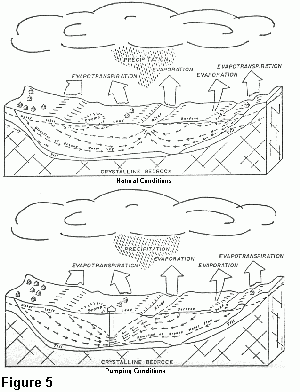 Under natural flow conditions, ground water is mainly discharged to nearby streams, lakes and estuaries or to the atmosphere by evaportranspiration. When water is withdrawn from wells the water table is lowered locally around the well (creating a cone of depression) and commonly is partially derived from adjacent surface water bodies (creating induced recharge). [See Figure 5] The hydraulic connection between ground water and surface water, the localized nature of most ground water flow systems, and the widespread coincidence of ground water and surface water drainage divides have played an important role in the development of Connecticut’s ground water management strategy.
Under natural flow conditions, ground water is mainly discharged to nearby streams, lakes and estuaries or to the atmosphere by evaportranspiration. When water is withdrawn from wells the water table is lowered locally around the well (creating a cone of depression) and commonly is partially derived from adjacent surface water bodies (creating induced recharge). [See Figure 5] The hydraulic connection between ground water and surface water, the localized nature of most ground water flow systems, and the widespread coincidence of ground water and surface water drainage divides have played an important role in the development of Connecticut’s ground water management strategy.

